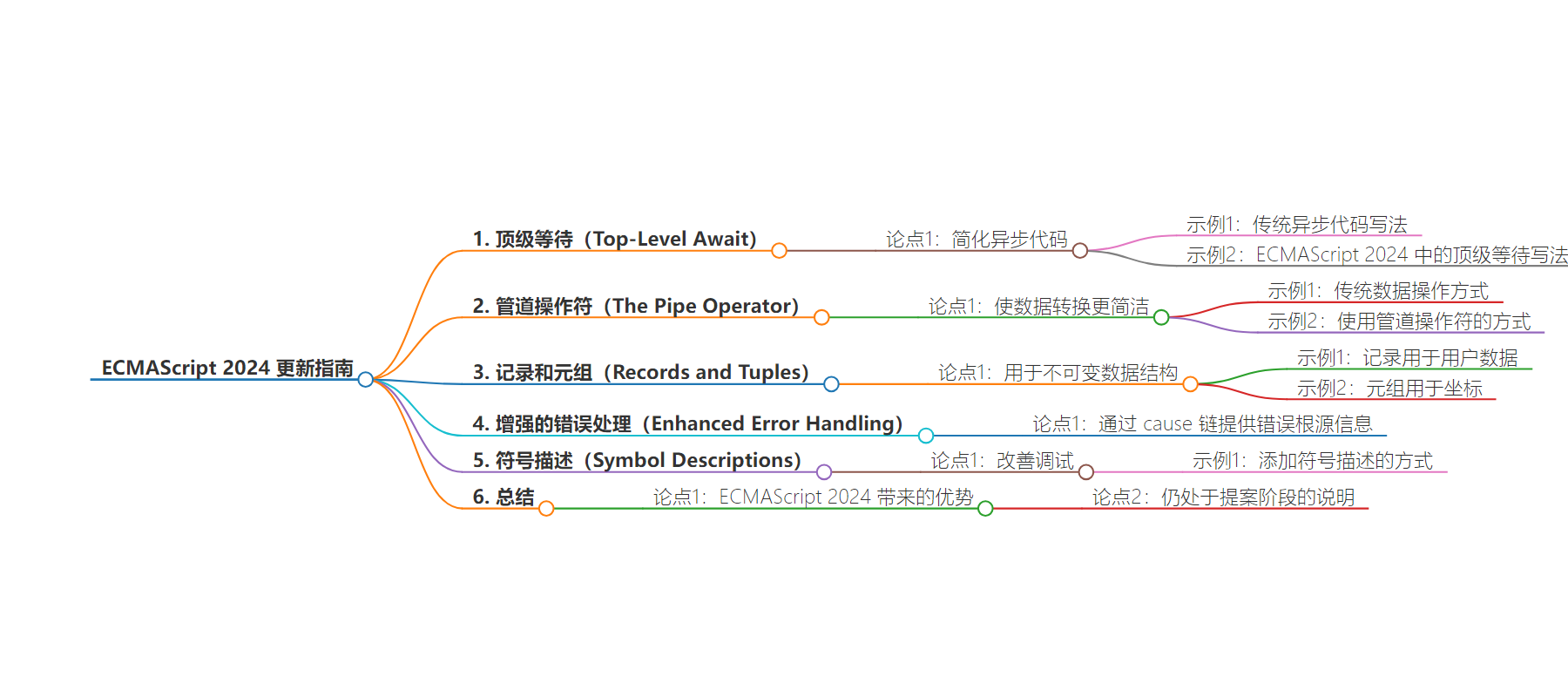包阅导读总结
1.
关键词:ECMAScript 2024、JavaScript、更新、特性、开发
2.
总结:本文介绍了 ECMAScript 2024 为 JavaScript 带来的一系列更新,包括顶级等待、管道操作符、记录和元组、增强的错误处理和符号描述等新特性,以提升代码可读性、效率和开发者体验。
3.
主要内容:
– 顶级等待(Top-Level Await)
– 传统异步编程方式的局限
– ECMAScript 2024 引入顶级等待的优势及示例
– 管道操作符(The Pipe Operator)
– 数据操作的常见任务
– 管道操作符提供更简洁的数据转换方式及示例
– 记录和元组(Records and Tuples)
– 作为新的不可变数据结构
– 记录与对象的相似性和不可变特性
– 元组的特点及应用示例
– 增强的错误处理(Enhanced Error Handling)
– 错误处理的重要性
– 通过 cause 属性实现错误链及示例
– 符号描述(Symbol Descriptions)
– 符号的作用
– 引入符号描述的好处及示例
– 总结
– ECMAScript 2024 新特性的优势
– 对开发者的意义及未来展望
思维导图:
文章地址:https://www.javacodegeeks.com/2024/07/a-guide-to-ecmascript-2024-updates.html
文章来源:javacodegeeks.com
作者:Eleftheria Drosopoulou
发布时间:2024/6/28 18:27
语言:英文
总字数:548字
预计阅读时间:3分钟
评分:89分
标签:ECMAScript,JavaScript,更新
以下为原文内容
本内容来源于用户推荐转载,旨在分享知识与观点,如有侵权请联系删除 联系邮箱 media@ilingban.com
ECMAScript, the foundation of JavaScript, undergoes regular updates to enhance its capabilities and keep pace with evolving web development needs. ECMAScript 2024, the latest iteration, brings a wave of exciting features designed to improve code readability, efficiency, and developer experience. This comprehensive guide delves into the key updates proposed for ECMAScript 2024, providing insights and practical examples to empower your JavaScript development journey.
1. Top-Level Await for Cleaner Asynchronous Code
Asynchronous programming is a cornerstone of modern web development. Traditionally, using async/await within non-async functions required wrapping the code in an async function or using Promise.then(). ECMAScript 2024 introduces top-level await, allowing you to directly use await at the top level of your script. This simplifies asynchronous code and improves readability:
// Before ES2024 (requires wrapping in async function)async function fetchData() { const response = await fetch('https://api.example.com/data'); const data = await response.json(); return data;}// After ES2024 (cleaner top-level await)async function fetchData() { const response = await fetch('https://api.example.com/data'); const data = await response.json(); return data;}(async () => { const userData = await fetchData(); console.log(userData);})();
2. The Pipe Operator for Streamlined Data Transformations
Data manipulation is a frequent task in JavaScript. ECMAScript 2024 introduces the pipe operator (|>) to provide a more concise and readable way to chain function calls for data transformations. This operator allows you to pipe the output of one function as the input to the next:
// Before ES2024 (multiple function calls)const doubledAge = calculateAge(user) * 2;// After ES2024 (cleaner pipe operator)const doubledAge = calculateAge(user) |> (age => age * 2);
3. Records and Tuples for Immutable Data Structures
Data immutability is a valuable concept for maintaining predictable and reliable code. ECMAScript 2024 introduces records and tuples as new immutable data structures. Records are similar to objects but offer a concise syntax for defining properties and enforcing immutability. Tuples are ordered collections of values, also immutable, ideal for representing fixed-length data:
// Record for user dataconst user = record({ name: "Alice", age: 30 });// Tuple for coordinatesconst coordinates = tuple(10, 20);console.log(user.name); // Output: "Alice"
4. Enhanced Error Handling with Cause Chaining
Error handling is crucial for robust applications. ECMAScript 2024 introduces the cause property on the Error object. This allows you to chain errors, providing valuable information about the root cause of an issue:
try { fetchData();} catch (error) { const networkError = new Error("Network Error"); networkError.cause = error; // Chain the original error throw networkError;}
5. Symbol Descriptions for Improved Debugging
Symbols are a unique data type used for object property keys. ECMAScript 2024 introduces symbol descriptions, allowing you to add a descriptive string to a symbol, making debugging and code comprehension easier:
const userSymbol = Symbol("user");userSymbol.description = "A symbol representing a user object";
Embrace the Future of JavaScript
ECMAScript 2024 brings a compelling set of features that empower developers to write cleaner, more efficient, and maintainable JavaScript code. By incorporating these updates into your development workflow, you can leverage the power of modern JavaScript and stay ahead of the curve. Thought, these features are still in the proposal stage, and their final implementation might differ, however, understanding these concepts will prepare you to utilize the full potential of JavaScript in the near future.
